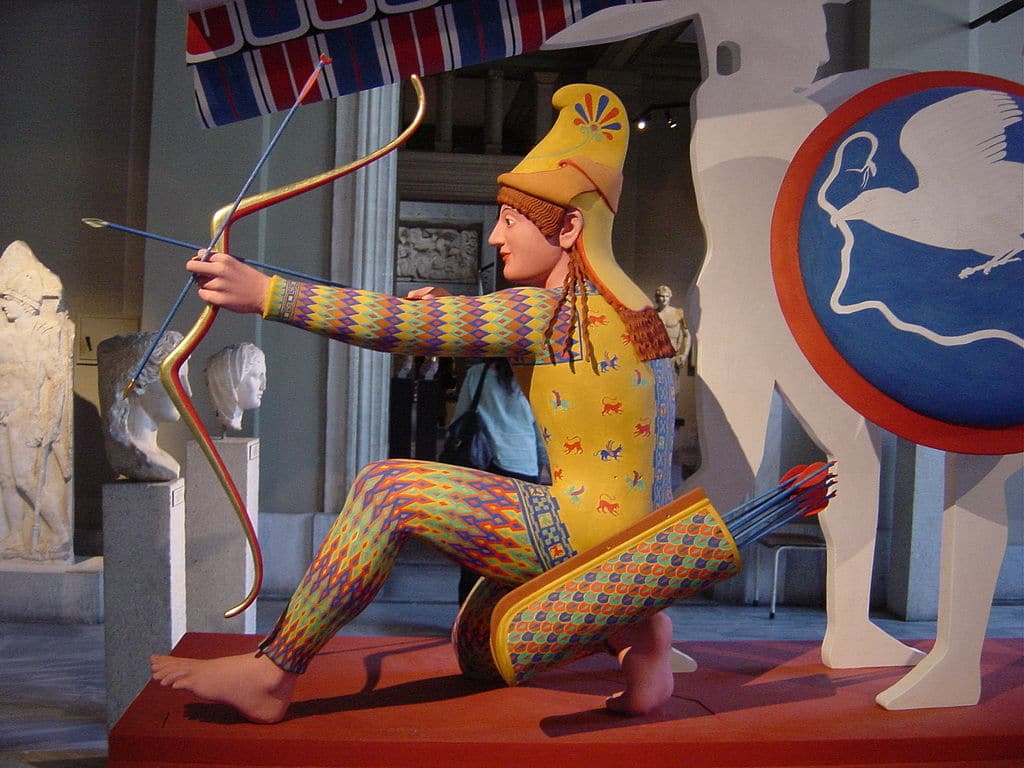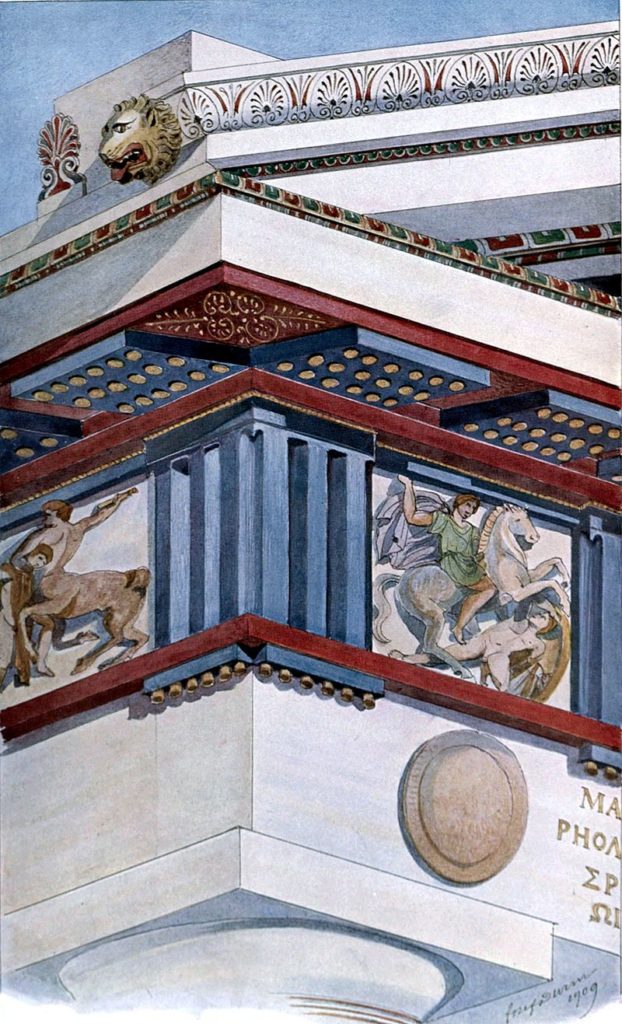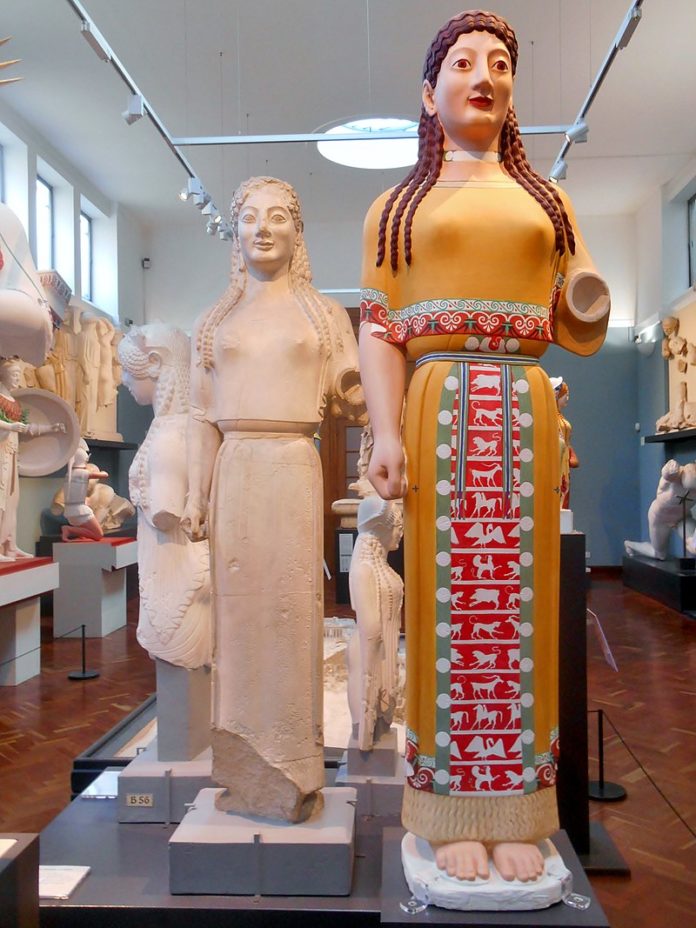By Philip Chrysopoulos | April 6, 2022

It is nearly impossible to imagine the sparkling white sculptures of ancient Greece painted in a variety of bright colors.
Marveling at the ancient Greek masterpieces today, there is a notion ingrained in our minds that all those magnificent sculptures were originally spotless white marble and time has robbed some of them of their glorious sheen.
We tend to think that iconic statues such as Hermes, the Winged Victory, and the Venus de Milo were plain marble sculptures that are just missing some parts, as well as their gleaming white skin.
However, it is now certain that ancient Greek sculptors used bright colors, as well as gold and ivory, to further beautify the magnificent structures they created.
In fact, most of them were dazzling in their color schemes, which was essential to the overall impact the sculptures were intended to create.
Ancient Greek sculptures were painted many bright colors

Phidias, the celebrated sculptor who created the masterpiece of the Parthenon, had sculpted a huge statue of Athena Parthenos to stand inside the great building.
Although the statue has long since been destroyed, there is a description of it in the writings of the ancient historian Pausanias, who wrote that the statue was “chryselephantine” or, in other words, covered in gold and ivory.
There is also a verse in Euripides‘ tragedy “Troades” (The Trojan Women), written in 415 BC, in which Helen says:
My life and fortunes are a monstrosity,
Partly because of Hera, partly because of my beauty.
If only I could shed my beauty and assume an uglier aspect
The way you would wipe color off a statue.
The last line clearly indicates that all sculptures had been colorfully painted and that this must have been essential to their beauty and impact.
Praxiteles, the creator of the famous Hermes and the Infant Dionysus, was once asked to identify his favorite statues. His reply was “The ones painted by Nikias.”
Unfortunately, after centuries of lying on the ground, the paint on the statues has been irreparably lost. Yet, there are remnants that, although not all visible to the naked eye, can be detected with modern technology.
Technology reveals the long-lost colors and paint of ancient Greek sculptures
Using non-destructive techniques, such as multifaceted imaging and elemental analysis with X-ray fluorescence, archaeologists and restorers are now able to largely recreate the original colorful appearance of the painted ancient Greek sculptures.
There was a pattern in the depiction of Ancient Greek sculptures: the gods had blonde hair which signified their nobility, and warriors had brown hair and skin while women, on the other hand, had white skin signifying the glory of their youth. Additionally, women were depicted also wearing makeup.

The “Peploforos,” or “Peplos Kore” in the Acropolis Museum has been reproduced along with her original vivid colors, according to the painstaking research of a team of conservationists.
She has auburn hair, scarlet lips, and brown eyes, and there are colorful decorative ribbons on her clothing.
As mentioned in a new article on the website of Smithsonian Magazine, German archaeologist Vinzenz Brinkmann has devoted intense effort to the reproduction of Ancient Greek sculptures in their original, dazzling colors. Using high-intensity lamps, ultraviolet light, cameras, plaster casts, and powdered minerals, Brinkmann has attempted to revive the brilliant glory of ancient Greece.
Brinkmann has also created full-scale plaster or marble copies which have been hand-painted in the same mineral and organic pigments employed by the ancients: green from the stone malachite, blue from azurite, yellow and ocher from arsenic compounds, red from cinnabar, and black from burned bone and vines.
Replicas of colorful Greek art displayed in museums around the world
Brinkmann has exhibited his collection of replicas in several museums around the world. His greatest honor was when his works were exhibited at the National Archaeological Museum of Athens, with top Greek government officials and renowned archaeologists attending the opening.
It was then when he had the opportunity to have some of his works photographed in front of the Parthenon, such as the brilliantly colored, exotic-looking Archer, a replica of a 490 BC Greek sculpture.
Today, with the aid of this modern technology, ancient Greek masterpieces can be reproduced as the polychromatic sculptures they were meant to be.
We are already amazed at the perfection of the white or ivory-hued ancient sculptures that we have seen for centuries and perhaps find it hard to believe any pigments could possibly enhance the perfection of these masterpieces.
Nonetheless, if more and more of these meticulously-accurate, painted copies begin to be exhibited in museums and other exhibition spaces, people will be once again be able to see them just as the ancient artists intended them to be viewed and admired.
Source: https://greekreporter.com/2022/04/06/ancient-greek-masterpieces-were-painted-in-dazzling-colors/
